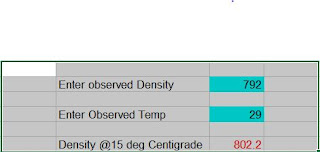- Patel’s laws of Gasoline 15c Density increasing
- Patel’s laws of Gasoline 15c Density increasing
Revised 19th Mar, 2018
1. Patel’s First law of Gasoline 15c Density increasing.
Gasoline Density is lowest at the time of its birth ie. first batch certification at manufacturing stage.
2. Patel’s Second law of Gasoline 15c Density increasing.
Gasoline 15c Density increases with time, if not stored in airtight containers.
Explanation: Gasoline evaporates at ambient temperature, losing lighter hydrocarbons like propane (-42C), propene (-47C), butane (-0.5C), butene (-6.1C), iso-pentane (27C), pentane (+36C). These lighter hydrocarbons have 15c density below 600 kg/m3. Figures in brackets are boiling points. In any gasoline sample, percentage of such volatile lighter hydrocarbons present equal to its reid vapour pressure in psia units. Container means here storage tanks, transport vehicle tanks and sample containers.
3. Patel’s Third law of Gasoline 15c Density increasing.
Gasoline 15c Density increases at relatively faster rate during product transfer from one container to other container and movement of product during its transportation.
Explanation: Gasoline evaporates at relatively faster rate during its movement in filling storage tanks, road and rail containers due to inter-molecular friction.
4. Patel’s Fourth law of Gasoline 15c Density increasing.
Gasoline 15c Density increases even ambient temperature is very very low (say -30 c), if not stored in airtight containers.
Explanation: See above at 2, since boiling point of evaporating hydrocarbons is very very low, there is product evaporation at ambient temperature of cold climate also.
5. Patel’s Fifth law of Gasoline 15c Density increasing.
Rate of Gasoline
15c Density increase is proportional to its evaporation which is directly
proportional to product Temperature, directly proportional to Vapour Pressure and
directly proportional to empty space in container.
Explanation: higher the evaporation, higher the loss of lighter hydrocarbon, resulting in denser the residual product
Keywords: ASTM Density Gasoline, Hydrocarbon
Evaporation
Follow me on
twitter @RJPatel13 to get notification when my new post is available
at my blog. https://twitter.com/rjpatel13?lang=en
*****************************************************************************

Comments